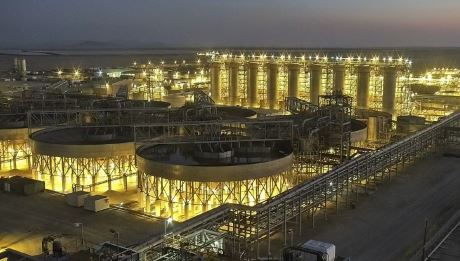Uranium suppliers dig in for long haul
16 September 2016
Representatives of both long-established and more recent mining operations yesterday debated issues related to the current market situation. They looked at patterns from past market cycles and the measures that producers are taking to position themselves now and in the future.
 |
| Operations at Husab, Namibia (Image: Swakop Uranium) |
Speaking at the World Nuclear Association's 41st Annual Symposium in London, Swakop Uranium's CEO Zheng Keping said the company’s Husab project, in Namibia has been ten years in the making. Swakop Uranium is owned by China's CGN-Uranium Resources Co, the China-Africa Development Fund and Namibian state-owned mineral exploration company Epangelo. Mining began in 2014 and the first stage of the processing plant was commissioned in July this year.
The mine's own sulphuric acid plant, capable of producing up to 1500 tonnes per day, began operation on 6 September. First production is expected in the coming weeks with the plant ramping up to nameplate over the next year, ultimately producing 15 million pounds U3O8 (5770 tU) per year.
Localisation has been an important part of company strategy to ensure sustainable and cost-effective operation, Zheng said, with the company training and developing a workforce that is more than 93% localised. The company expects to reach its target of 95% by early 2017.
Learning from experience
Energy Fuels' chief operating officer Mark Hall looked at the history of the uranium markets to ask whether analogies could be drawn to today's situation. He said uranium production lags behind uranium price run-ups by about five to ten years, before dropping off again. He identified the "coma" years - between 1987 and 2005 with low prices, stagnant uranium demand and high inventories - and the "renaissance" years - from 2004 to 2013 when prices remained above $30 per pound U3O8 as demand was expected to "skyrocket", and substantial equity capital was available to mining companies.
Hall questioned whether, since 2013, the "coma" period has returned. Limited investment in new uranium projects, with mines shutting or being placed on care and maintenance, observed in the current period, are similar to the situation during the "coma" years, but differences also exist. Unlike during the coma years, reactor growth, uranium demand, and forward demand forecasts are all increasing. While excess inventories exist these are at substantially lower levels than in the early 1990s, and no new exploration is being carried out to replace low-cost deposits being mined today. This would be expected to result in an increase in production, he said.
He concluded that most current primary production is not sustainable at current prices, and with many long-term legacy contracts for uranium sales expiring in 2017-2018 many mines can be expected to close. With a major mine taking five to ten years from exploration to construction and ramp-up, production will not increase quickly enough when the market calls for it, he said. Current and future projects need uranium prices of at least $50 per pound to justify production, he added.
"Will history repeat? We'll find out soon enough," he said, warning of a "world of hurt" for producers "if things don't change pretty quickly".
Namibian strategy
Paladin Energy intends to remain a sustainable long-term supplier and is adapting to the downturn in uranium, its CEO Alexander Molyneux said. The Langer Heinrich mine in Namibia is a "strategic tier 1 mine", he said, and the company aims to maximise cash flow through optimisation, without breaching the integrity of its long-term mining plan.
A major step in the optimisation process has been the installation of a bicarbonate recovery facility: a nanofiltration plant. This separates bicarbonate after the leaching phase, allowing the reagent to be recycled. This has resulted in a reduced cash cost of finished production by $6 per pound, he said. The plant cost $6 million to build and is enabling savings of about $36 million per year.
While the company has the scope to cut costs further, changes to the business plan mean that some capabilities have been lost, Molyneux said. With the Kayelekera mine in Malawi on care and maintenance, it cannot expand its business rapidly - it would probably take 18-24 months to bring the mine back into production, he said.
Difficult but not desperate
Tim Gabruch, Cameco's vice president of marketing, said the uranium industry was facing very difficult, but not desperate, times.
The near- to medium-term market is difficult for primary producers like Cameco, Gabruch said. The availability of excess supply has served to produce a buyer's market, manifesting itself in shifting trends of how nuclear fuel is contracted, he said. These do not necessarily support the long-term wellbeing of the producer.
Gabruch, like other speakers, pointed to Japan as a key area of uncertainty in the uranium industry. While Japanese uncertainty had the single most significant impact on uranium demand, there have been other factors, including post-Fukushima closures of German capacity and the premature closures of some US units for economic reasons.
On the supply side, Gabruch said there was "no question" that a price environment encouraging new supply was not being created or that this was leading to contraction of the supply sector. Although curtailments to date have seen about 16 million pounds of supply removed from global supply, the adjustments have not been great enough to counter the reduction in demand and to have an effect on price, he said.
Producers need to continue to be flexible under current market conditions, he said. Cameco suspended production at Rabbit Lake in Canada and curtailed output at its US operations. It has focused instead on its "tier 1" assets of McArthur River and Cigar Lake in Canada and Inkai in Kazakshtan, and is prepared to make further adjustments if required, Gabruch said.
Researched and written
by World Nuclear News